by Mark Havenhand
for shanghaibirding.com

After an absence of two years from China, and having got word that the border regions of Yunnan-Myanmar were once more open, it was time for a revisit. On 14 February I flew into Kunming via Bangkok then took a short flight to Tengchong, elev. 1650 m (5,410 ft.). The town has modernised and gotten bigger but still has charm and is pleasant to walk around in. I stayed at the Xinghua Hotel (25.032725, 98.489978). This hotel is near Laifengshan (25.017876, 98.478708), a birding hotspot I knew from eight years back.
I birded three thoroughly enjoyable days at Laifengshan. I recorded 51 species, all concentrated in a small area. Access was easy, temperatures (around 22°C or 72°F) pleasant. There were not too many people and plenty of opportunities to go off-piste. The mountain has mature trees at the top and thick subtropical undergrowth at the bottom (parrotbills, minlas, yuhinas, white-eyes, warblers). There is an extensive deciduous part on the slopes facing away from Tengchong that would probably reward further study. The tops have woodpeckers, nuthatches, tits, and thrushes. All in all Laifengshan is a great place to get refamiliar with Yunnan species and get acclimatised. I gave the “old town” of Heshun a miss, but I believe the lower-lying paddyfields would also be productive.
Next up was the public bus to Yingjiang (90 minutes, 60 RMB) then a taxi (300 RMB) to Hongbenghe (24.437693, 97.533178) on the border with Myanmar. Hongbenghe is a one-street town without much accommodation, and birding seems to be the only reason to be there. The locals in this area are Kachin, Christian, and speak Chinese with a strong accent. I met no one who spoke English the whole trip and saw no other foreigners (apart from Burmese). There is a prominent police station in the middle of the street. The official checked my passport in a low-key way. I ate in the two restaurants, which were both OK.
Without transport, options around Hongbenghe are limited. I walked up the ridge about 3 km (2 mi.) towards Shiti village and tracked my first Wreathed Hornbill, Collared Falconet, and a group of Fire-capped Tit. I found as well many Black Giant Squirrel Ratufa bicolor. The village trees hum with barbets, leafbirds, doves, and drongos.
Two nights later I moved to Shiti (24.470818, 97.572840), a village 5 km (3 mi.) up the mountain. I birded here three days and recorded 89 species. Shiti was significantly cooler than Hongbenghe and had better and more hotels and two restaurants and two shops. Again, accommodation is tight, and the well-prepared will book ahead on Chinese hotel sites.
The place is well-known to Chinese birders; at the most popular hides there were 20 or more birders and hardly a spare seat. You need to reserve if you wish to avoid disappointment. The hides are well signposted (“niaotang/bird pond”) and mostly involve dropping down 100–200 m from the ridge road into the primary forest. Nearly all hides had food and water available for Yunnan specialties Velvet-fronted Nuthatch and Puff-throated Babbler plus rarities such as Grey Peacock-Pheasant, Kalij Pheasant, and Rusty-naped Pitta. There is a slow period from 12:30–4 p.m., when the temperature can reach 30°C (86°F).
To see other species such as raptors, hornbills, and Long-tailed Sibia, you need to walk the forest paths. The forest looks pristine at first sight but is actually far from it. Pessimists may note the forest is being cleared to make way for “organic” coffee—surely in terms of biodiversity loss the world’s most expensive brew.
The village is swept clean with wooden houses and flower gardens. In February it was fresh in the morning (jacket needed) and cool at night. As well as the many birds there were many butterflies—Great Orange-tip ssp. danaus and many Paris Peacock Papilio paris to be seen hill-topping in the hot afternoons.
I loved Shiti. The birding there is just extraordinary—for me, better than Baihualing and Nabang.
On the way back to Tengchong I stopped at Yingjiang Wetland (24.689436, 97.934190), where there is a walk by the Daying River several kilometres long. The route leads through forest and reeds, and the boardwalk is rotting, but I kept on. I spotted Temminck’s Stint, River Lapwing, Grey-headed Lapwing, and Grey-throated Martin as well as Little Ringed Plover in almost continuous flight. There were several Alexandrine Parakeet flying high through the trees. Finally leaving Yingjiang about 10 km (6 mi.) towards Tengchong I stopped at the River Tern site (24.694007, 97.989095). There, I saw 2 (50%) of China’s population. They are a magnificent bird. The site is not protected at all, and I fear their future is not bright at that place.
All Covid measures are history; a few old signs are just that—old. The anti-foreigner sentiment that was a feature of my previous Yunnan trips has gone, and several people were very friendly to me. The police have also dialed back their powers; going into Hongbenghe, I had the briefist of passport checks. Coming from Yingjiang to Tengchong (leaving Hongbenghe) I was questioned for over an hour by the police who, seeing my muddy boots and tanned face, assumed I had walked in from Myanmar (disregarding the entrance stamp from Kunming).
Any regret? I should have walked all the way from Shiti to the river on the valley floor forming the border with Myanmar. A bit of a trek but would have been interesting. An extra day in Shiti would have been good.
With inadequate torches, an attempt at owling was a failure—Brown Wood Owl and Mountain Scops Owl heard but not seen. There is quite a circus, which I did not join, around Great Hornbill. (I saw the species elsewhere, though.)
There are no banks for miles; if you do not have Alipay then take a pile of cash. I suggest 300 RMB per day for food, accommodation, and any taxis. I took a local guide for some half-days at 400 RMB per half-day, which usually ran from 8:15 a.m. to 2 p.m.
PHOTOS
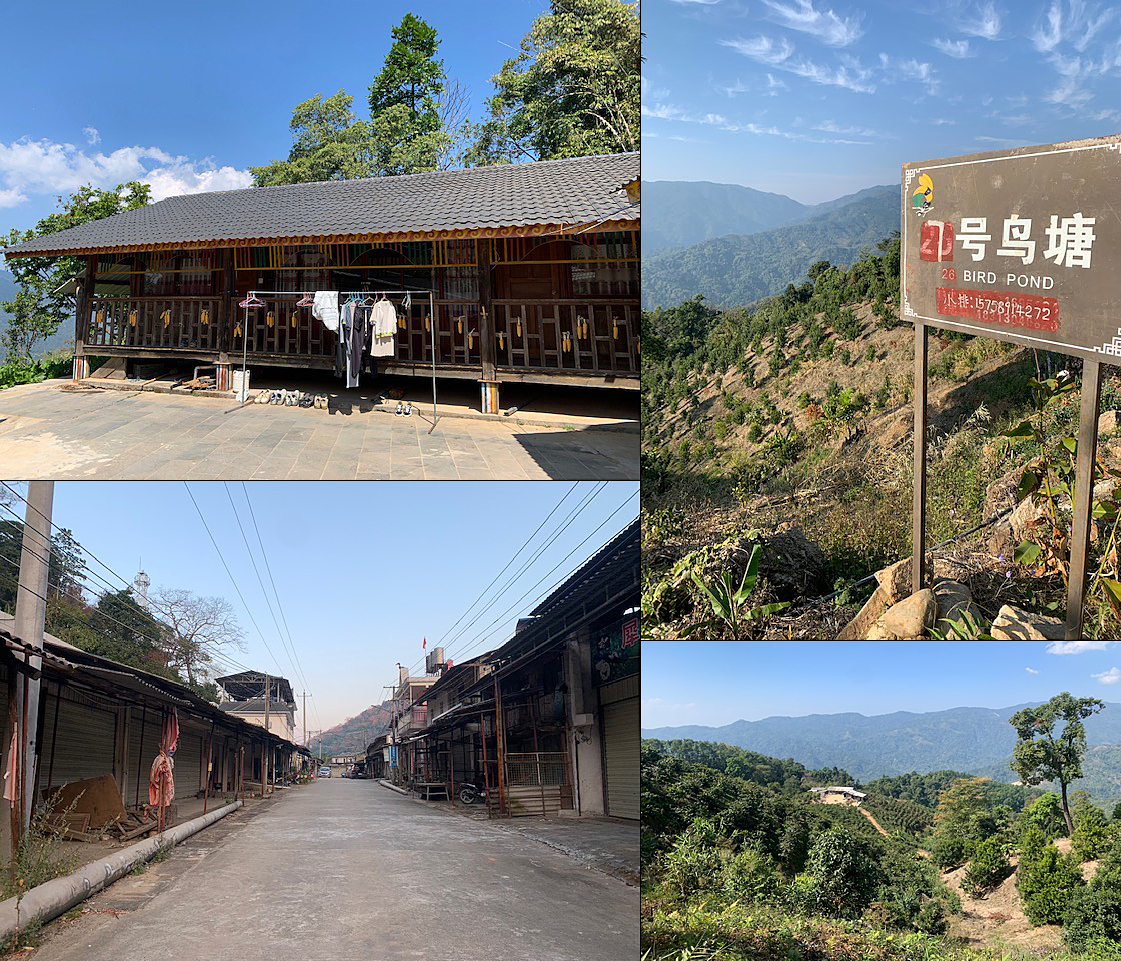

BIRD LIST
The following is the list of birds Mark Havenhand noted in western Yunnan in February 2024. Hyperlinks connect to entries in Craig Brelsford’s Photographic Field Guide to the Birds of China, published in its entirety on this website:
Ruddy Shelduck Tadorna ferruginea
Indian Spot-billed Duck Anas poecilorhyncha
Common Merganser Mergus merganser
Red Junglefowl Gallus gallus
Kalij Pheasant Lophura leucomelanos
Grey Peacock-Pheasant Polyplectron bicalcaratum
Crested Treeswift Hemiprocne coronata
House Swift Apus nipalensis
Square-tailed Drongo-Cuckoo Surniculus lugubris
Oriental Turtle Dove Streptopelia orientalis
Spotted Dove Spilopelia chinensis
Common Emerald Dove Chalcophaps indica
Barred Cuckoo-Dove Macropygia unchall
River Lapwing Vanellus duvaucelii
Grey-headed Lapwing V. cinereus
Little Ringed Plover Charadrius dubius
White-breasted Waterhen Amaurornis phoenicurus
Temminck’s Stint Calidris temminckii
Common Snipe Gallinago gallinago
Common Sandpiper Actitis hypoleucos
River Tern Sterna aurantia
Great Cormorant Phalacrocorax carbo
Chinese Pond Heron Ardeola bacchus
Little Egret Egretta garzetta
Crested Goshawk Accipiter trivirgatus
Shikra A. badius
Eurasian Sparrowhawk A. nisus
Rufous-winged Buzzard Butastur liventer
Oriental Honey Buzzard Pernis ptilorhynchus orientalis
Himalayan Buzzard Buteo burmanicus
Mountain Scops Owl Otus spilocephalus*
Brown Wood Owl Strix leptogrammica*
Wreathed Hornbill Rhyticeros undulatus
Oriental Dollarbird Eurystomus orientalis
White-throated Kingfisher Halcyon smyrnensis
Chestnut-headed Bee-eater Merops leschenaulti
Great Barbet Psilopogon virens
Blue-throated Barbet P. asiaticus
Blue-eared Barbet P. cyanotis
Coppersmith Barbet P. haemacephalus
Speckled Piculet Picumnus innominatus
Grey-capped Pygmy Woodpecker Yungipicus canicapillus
Stripe-breasted Woodpecker Dendrocopos atratus
Great Spotted Woodpecker D. major
Greater Yellownape Chrysophlegma flavinucha
Laced Woodpecker Picus vittatus†
Grey-headed Woodpecker P. canus
Collared Falconet Microhierax caerulescens
Alexandrine Parakeet Psittacula eupatria
Rusty-naped Pitta Hydrornis oatesi
Ashy Woodswallow Artamus fuscus
Short-billed Minivet Pericrocotus brevirostris
Burmese Shrike Lanius collurioides
Long-tailed Shrike L. schach tricolor
Grey-backed Shrike L. tephronotus
Black-headed Shrike-babbler Pteruthius rufiventer
White-browed Shrike-babbler P. aeralatus
Maroon Oriole Oriolus traillii
Slender-billed Oriole O. tenuirostris
Bronzed Drongo Dicrurus aeneus
Greater Racket-tailed Drongo D. paradiseus
Ashy Drongo D. leucophaeus hopwoodi
White-throated Fantail Rhipidura albicollis
Collared Treepie Dendrocitta frontalis
Yellow-bellied Fantail Chelidorhynx hypoxanthus
Grey-headed Canary-flycatcher Culicicapa ceylonensis
Fire-capped Tit Cephalopyrus flammiceps
Sultan Tit Melanochlora sultanea
Japanese Tit Parus cinereus commixtus
Yellow-cheeked Tit Machlolophus spilonotus
White-throated Bulbul Alophoixus flaveolus
Mountain Bulbul Ixos mcclellandii
Black Bulbul Hypsipetes amaurotis
Black-crested Bulbul Rubigula flaviventris
Crested Finchbill Spizixos canifrons
Flavescent Bulbul Pycnonotus flavescens
Red-whiskered Bulbul P. jocosus
Red-vented Bulbul P. cafer
Sooty-headed Bulbul P. aurigaster
Grey-throated Martin Riparia chinensis
Barn Swallow Hirundo rustica
Asian Stubtail Urosphena squameiceps
Buff-barred Warbler Phylloscopus pulcher
Sichuan Leaf Warbler P. forresti
Grey-crowned Warbler P. tephrocephalus
Striated Grassbird Megalurus palustris
Rufescent Prinia Prinia rufescens
Plain Prinia P. inornata
Yellow-bellied Warbler Abroscopus superciliaris
Black-faced Warbler A. schisticeps
Aberrant Bush Warbler Horornis flavolivaceus
Grey-bellied Tesia Tesia cyaniventer
Black-browed Bushtit Aegithalos bonvaloti
Spectacled Fulvetta Fulvetta ruficapilla
Rufous-headed Parrotbill Psittiparus bakeri
Brown-winged Parrotbill Sinosuthora brunnea
Striated Yuhina Staphida castaniceps
Whiskered Yuhina Yuhina flavicollis
Chestnut-flanked White-eye Zosterops erythropleurus
Indian White-eye Z. palpebrosus
Pin-striped Tit-Babbler Mixornis gularis
Rufous-capped Babbler Cyanoderma ruficeps
Red-billed Scimitar Babbler Pomatorhinus ochraceiceps
Streak-breasted Scimitar Babbler P. ruficollis
Large Scimitar Babbler Erythrogenys hypoleucos
Grey-throated Babbler Stachyris nigriceps
Spot-necked Babbler S. strialata
White-hooded Babbler Gampsorhynchus rufulus
Rufous-winged Fulvetta Schoeniparus castaneceps
Puff-throated Babbler Pellorneum ruficeps
Brown-cheeked Fulvetta Alcippe poioicephala
Nepal Fulvetta A. nipalensis
Yunnan Fulvetta A. fratercula
Blue-winged Laughingthrush Trochalopteron squamatum
Red-tailed Laughingthrush T. milnei
Long-tailed Sibia Heterophasia picaoides
Grey Sibia H. gracilis
Black-headed Sibia H. desgodinsi
Blue-winged Minla Actinodura cyanouroptera
Red-billed Leiothrix Leiothrix lutea
Silver-eared Mesia L. argentauris
Red-tailed Minla Minla ignotincta
Rufous-backed Sibia Leioptila annectens
Red-faced Liocichla Liocichla phoenicea
White-crested Laughingthrush Garrulax leucolophus
Black-throated Laughingthrush Pterorhinus chinensis
Greater Necklaced Laughingthrush P. pectoralis
Velvet-fronted Nuthatch Sitta frontalis
White-tailed Nuthatch S. himalayensis
Chestnut-vented Nuthatch S. nagaensis
Common Hill Myna Gracula religiosa
Collared Myna Acridotheres albocinctus
Black-collared Starling Gracupica nigricollis
Chestnut-tailed Starling Sturnia malabarica
Black-breasted Thrush Turdus dissimilis
Grey-winged Blackbird T. boulboul
Oriental Magpie-Robin Copsychus saularis
White-rumped Shama C. malabaricus
Pale Blue Flycatcher Cyornis unicolor
Hill Blue Flycatcher C. whitei
Large Niltava Niltava grandis
Small Niltava N. macgrigoriae
Rufous-bellied Niltava N. sundara
White-tailed Robin Myiomela leucura
Himalayan Bluetail Tarsiger rufilatus
Red-flanked Bluetail T. cyanurus
Golden Bush Robin T. chrysaeus
Blue Whistling Thrush Myophonus caeruleus eugenei
Rufous-gorgeted Flycatcher Ficedula strophiata
Little Pied Flycatcher F. westermanni
Slaty-blue Flycatcher F. tricolor
Black Redstart Phoenicurus ochruros
Daurian Redstart P. auroreus
Asian Rock Thrush Monticola solitarius pandoo
Chestnut-bellied Rock Thrush M. rufiventris
White-throated Rock Thrush M. gularis
Siberian Stonechat Saxicola maurus
Grey Bush Chat S. ferreus
Blue-winged Leafbird Chloropsis cochinchinensis
Golden-fronted Leafbird C. aurifrons
Orange-bellied Leafbird C. hardwickii
Mrs. Gould’s Sunbird Aethopyga gouldiae
Black-throated Sunbird A. saturata
Streaked Spiderhunter Arachnothera magna
Grey Wagtail Motacilla cinerea
White Wagtail M. alba
Little Bunting Emberiza pusilla
* heard only
† Hide 7, upper Shiti village
MORE ON BIRDING IN YUNNAN
Read Mark Havenhand’s series on birding in western Yunnan:
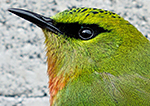
• Fire-tailed Myzornis at Pianmazhen, Near the Sino-Burmese Border in Western Yunnan: Mark Havenhand made his brief visit count, netting exhilarating views of Himalayan species Fire-tailed Myzornis plus other regional specialties such as Black-hooded Oriole. “The whole region is a paradise for the fit birder,” writes Havenhand.

• I Birded Yunnan’s Salween Valley but Was Unable to Bird the Dulong Gorge: Stymied in his quest to bird Dulong Gorge, Mark Havenhand more than made do in the majestic Nujiang or Salween Valley, noting western Yunnan specialties Davison’s Leaf Warbler and Beautiful Sibia.
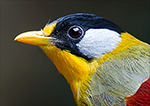
• Birding Baihualing, China’s Greatest Birding Hotspot, Amid the Pandemic: Mark Havenhand squeezed in 2½ productive days at the birders’ mecca in the Gaoligong Mountains. Havenhand noted many specialties of western Yunnan, among them Silver-eared Mesia and Flavescent Bulbul. Was a visit to the partially closed resort worth it? Click to read Havenhand’s advice.
Enjoy even more of our extensive coverage of birding in western Yunnan:
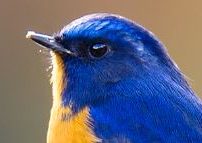
• Eastern Himalayan Birds in the Majestic Dulong Gorge: We birded the remote valley in northwest Yunnan, noting 170 species. Among our many spectacular finds were flocks of 300 Grandala, Ibisbill in the thundering Dulong River, and one of the world’s least-known deer, the mysterious Gongshan Muntjac. We noted western Yunnan specialties Rufous-breasted Bush Robin and Golden-naped Finch.
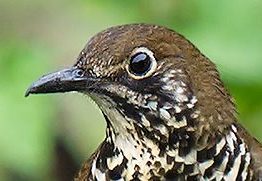
• Himalayan Thrush and Fire-tailed Myzornis in Dulong Gorge: shanghaibirding.com founder Craig Brelsford became one of the first birders to visit Dulong Gorge in northwest Yunnan. In collaboration with Per Alström, Brelsford photographed and sound-recorded Himalayan Thrush. Brelsford’s team found the exquisite Fire-tailed Myzornis as well as other species with limited ranges in China, among them Scaly Laughingthrush and Scarlet Finch.

• Himalayan Specialties in Yunnan’s Gaoligong Mountains: This 47-day expedition included visits to Tengchong and Nabang and 25 nights at Baihualing in Yunnan’s Gaoligong Mountains. At Baihualing, we visited the bird-photography blinds, finding there Slender-billed Scimitar Babbler, Grey-sided Laughingthrush, and Red-tailed Laughingthrush. In Nabang on the border with Burma, we found several species whose ranges just touch China, among them Wreathed Hornbill and Black-backed Forktail.
Featured photo: During his trip to western Yunnan in February 2024, shanghaibirding.com contributor Mark Havenhand noted birds that in China occur mainly or exclusively in Yunnan. Among them are, clockwise from L: Velvet-fronted Nuthatch Sitta frontalis, Puff-throated Babbler Pellorneum ruficeps, Long-tailed Sibia Heterophasia picaoides, Blue Whistling Thrush Myophonus caeruleus eugenei, and River Lapwing Vanellus duvaucelii. All photos taken in Yunnan by shanghaibirding.com founder Craig Brelsford.


Shiti/Nabang/Yingjiang are all great birding areas, and thanks for the reminder of what charismatic birds they hold.
I’m a fervent birder from The Netherlands. I’m planning a trip to Yunnan this April with my girlfriend (from Luoyang, Henan). I would love to dedicate a few days to birding and have read the blogs on your website (especially those by Mark Havenhand). It would be fantastic if you could help me out with a couple of questions.
I’m already planning to visit Tengchong for several days (e.g. Laifengshan) and afterwards travel to either Shiti village, Baihualing or Naban. The type of birding I enjoy most is walking through local areas to find species by myself (i.e. without a guide). Any of the hornbill species would be a dream, but as nearly all species in this region are new for me I would enjoy finding and identifying other species just as much. I have seen that there are lots of bird ponds maintained by the local community, but as this slightly evokes a ‘zoo feeling’ this has less of my interest (although I will probably spend at least some time at these hides if possible).
Based on the blogs on your website I think it would be difficult for me to walk around by myself in Baihualing concerning the police force in this area (and the risk of the area being closed off for foreigners). The same might be true for Nabang being so closely located on the border with Myanmar. I was thus considering Shiti as the best option, also based on the post by Mark Havenhand: “I loved Shiti. The birding there is just extraordinary—for me, better than Baihualing and Nabang.”. We have already seen that there are some options for accommodation in Shiti village and we will be bringing our own (Chinese) driver.
I was wondering whether you have any tips for my visit. Do you indeed think Shiti village is indeed the best option? Would it be possible for me to walk around with my girlfriend (and maybe the driver) to look for birds ourselves without using the ‘bird ponds’? Mark Havenhand wrote: “To see other species such as raptors, hornbills, and Long-tailed Sibia, you need to walk the forest paths”. Do you have any pointers on where these forest paths can be found? Do they all start close to Shiti village? And finally, if I would like to use any of the bird ponds, do I need to reserve these in advance? Or would it be possible to arrange this once we are there and pay by cash?
China changes fast but i can give my info gladly.
Baihualing – would drop – it’s away from the other places, does not support independent roaming and is a shadow of its former self. Seems to be something there we should not see. If adventurous you could try the same ridge from the Western side approached from Tengchong – this worth a try with your own transport. I never did it but have heard good reports
Nabang in my day was OK for walking, but the opportunities there are limited by the Burma border – you can no longer cross – I would say the site is max 20% as big as Shiti – 1-2 days would cover it
Shiti is a stretched out village maybe 2km long, there are 1-2 shops hidden in huts which may only open a few hours, maybe 2 basic restaurants and 2-3 basic hotels. You probably should load up the car with some biscuits, fruit etc there is really little up there.
It’s on a ridge so any walking is usually down then back up – steepish but not crazy. I think the place is at about 2000m you could check that. In April it will definitely be hot, i guess 35C+ in the valley, maybe 30C on the ridge, cools off at night. In February early morning before about 8am i needed a jacket. During the day i think you will need a sun hat.
There are many paths you can easily find going off the ridge road in both directions (towards and away from Burma). No maps of course. The ponds are really basic up there, no need to book can drop in. Nobody asked me for money but i guess a token for keeping the place clean is OK. Spotting birds in a tropical forest is not easy, the hornbills are usually seen early morning at open viewpoints – there is a good place at the entrance to the ridge next to some kind of Government tower – and evening at dusk flying home. They perch conveniently on bare branches. I think a good walker would be happy 5 days easily in Shiti. There is also a good river section with China’s only River Terns on the way – i think the place is called Yinchang it must be in my report, worth seeing.
The local people don’t speak English and are very friendly, quite a few Burmese walk over to say hi, the serious control is on the highway heading back out – with sunburn and muddy boots they assumed i had walked in from Burma. There is no fighting in that area and no military presence.
Fantastic! Thank you so much for your quick response and confirming the choice for Shiti. We will make sure to properly prepare for the conditions.
I have also found the location for the River Terns in your blog and it’s definitely high on the list for a quick visit!